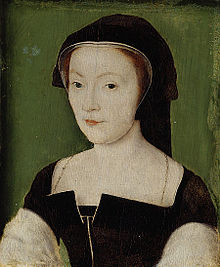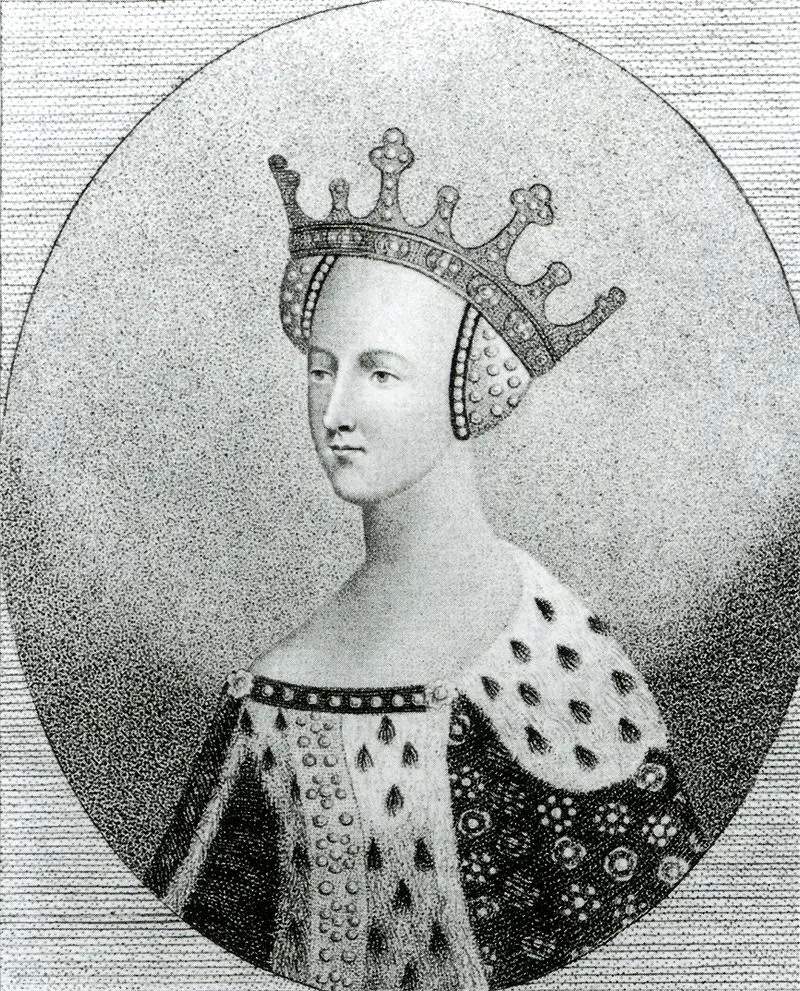Mary, Queen of Scots, lost her life on 8 February 1587. She was not buried for almost a full five months, finally being laid to rest on 5 August 1587 in Peterborough Cathedral. Peterborough Cathedral already had one queen buried there, namely Katharine of Aragon, buried in 1536.
Peterborough Cathedral has an impressive history beginning in 655 BCE when the site was home to a monastery. During the years surrounding 1116, the bulk of the Anglo-Saxon Chronicle was written at Peterborough. Skipping ahead to 1530, Cardinal Wolsey celebrated Easter at Peterborough after he was sent into exile by Henry VIII. In 1536, Katharine of Aragon was buried at Peterborough. Mary, Queen of Scots, was buried at the cathedral, as mentioned above, as it was close to Fotheringhay Castle, where Queen Mary was beheaded.
 When Mary’s son, James VI, became James I of England in 1603, he did not immediately take action to move his mother. However, James did encourage rehabilitating his mother’s reputation via that favourite device of Tudor propaganda, portraiture. James was descended from the Tudors - his great-grandmother was Margaret Tudor, and his great-great-grandfather was Henry VII. A well-recognized portrait of Mary, Queen of Scots, was painted between 1610-1615. The portrait is held by the National Galleries of Scotland, and depicts Mary wearing a black gown and white veil; perhaps an allusion to what she wore on the day of her death. A rosary dangles from Mary’s waist. The rosary makes a quiet political declaration, in that it features a depiction of Susanna with the Elders; Susanna was blackmailed by two elders who saw her bathing. If she did not agree to relations with them, she would be put to death. It was later discovered that the elders were lying, and so Susanna was allowed to live. This allegory of virtue seems to speak to James’s desire, or at least, the patron’s desire, to show that Mary was free of any wrongdoing that led to her death.
When Mary’s son, James VI, became James I of England in 1603, he did not immediately take action to move his mother. However, James did encourage rehabilitating his mother’s reputation via that favourite device of Tudor propaganda, portraiture. James was descended from the Tudors - his great-grandmother was Margaret Tudor, and his great-great-grandfather was Henry VII. A well-recognized portrait of Mary, Queen of Scots, was painted between 1610-1615. The portrait is held by the National Galleries of Scotland, and depicts Mary wearing a black gown and white veil; perhaps an allusion to what she wore on the day of her death. A rosary dangles from Mary’s waist. The rosary makes a quiet political declaration, in that it features a depiction of Susanna with the Elders; Susanna was blackmailed by two elders who saw her bathing. If she did not agree to relations with them, she would be put to death. It was later discovered that the elders were lying, and so Susanna was allowed to live. This allegory of virtue seems to speak to James’s desire, or at least, the patron’s desire, to show that Mary was free of any wrongdoing that led to her death.
By 1612, James had a marble tomb created for his mother in the Lady Chapel of Westminster Abbey. Her body was exhumed and moved from Peterborough to Westminster Abbey in October 1612. Today, there hangs a flag of Scotland in Peterborough Cathedral where Mary’s tomb used to be. Her tomb in Westminster Abbey is striking. The nearby shared tomb of Mary I and Elizabeth I almost pales in comparison to the sheer magnificence and care put into Mary’s tomb. Mary’s effigy is atop the tomb, and very lengthy inscriptions in Latin can be found on the tomb.* Certain excerpts from the inscription show an attempt to rehabilitate Mary’s legacy:
[...] sure and certain heiress to the crown of England while she lived: mother of James, most puissant sovereign of Great Britain…after she had been detained in custody for more or less twenty years, and had courageously and vigorously, (but vainly), fought against the obloquies of her foes, the mistrust of the faint-hearted, and the crafty devices of her mortal enemies, she was at last struck down by the axe (an unheard-of precedent, outrageous to royalty)… to James her son the hope of a kingdom and posterity, and to all who witnessed her unhappy murder an ensample of endurance….
Mistress of Scotland by law, of France by marriage, of England by expectation, thus blest, by a three-fold right, with a three-fold crown; happy, ah, only too happy, had she routed the tumult of war, and, even at a late hour, won over the neighbouring forces… here lies buried the daughter, bride and mother of kings. God grant that her sons, and all who are descended from her, may hereafter behold the cloudless days of eternity….
Mary’s much taller tomb is just the across the way from that of Elizabeth I and Mary I of England. Perhaps by making such a statement with his mother’s tomb, James I and VI was taking further steps to redeem Mary, Queen of Scot’s public image. She was no longer the ever-present threat to stability and the monarch of England, but rather the parent of the monarch and the person responsible for the unity of Scotland and England.
Heather R. Darsie lives in the United States with her family and three parrots. She works in the legal field, with a focus on children. She obtained a Bachelor of Arts degree in German Languages and Literature, then a Juris Doctorate in American jurisprudence, and studied abroad in Costa Rica and France. Heather has always loved history. She first became acquainted with Elizabeth I when she was in middle school and chose to write a book report about her. Since then, she has always held an interest in the Renaissance and its numerous enigmatic citizens, with particular focus on the history of England and Italy. She is currently working on a book on the heraldry of Tudor women and is also researching Anne of Cleves.
Sources and Suggested Reading
* Please visit http://www.westminster-abbey.org/our-history/royals/mary-queen-of-scots for the inscriptions. They are voluminous, compared to what is written on Elizabeth I’s tomb.
Pictures: 1) A copy of the effigy on Mary's tomb in Westminster Abbey, London. National Museum of Scotland exhibit, photo by Kim Traynor, Geograph.org.uk. You can see photos of Mary's tomb in Westminster Abbey at http://www.westminster-abbey.org/our-history/royals/mary-queen-of-scots. 2) Mary, Queen of Scots, National Galleries of Scotland.
- “A Peterborough Cathedral Timeline.” http://www.peterborough-cathedral.org.uk/history.aspx Retrieved 6 February 2017.
- “Peterborough Cathedral.” http://easterncathedrals.org.uk/members/peterborough-cathedral.php Retrieved 6 February 2017.
- Portrait of Mary, Queen of Scots, held by the National Galleries of Scotland. https://art.nationalgalleries.org/art-and-artists/3235/mary-queen-scots-1542-1587-reigned-1542-1567-about-1610-1615?search_set_offset=0#more-Info Retrieved 10 February 2017.
- Westminster Abbey. “Elizabeth I.” http://www.westminster-abbey.org/our-history/royals/elizabeth-i Retrieved 9 February 2017.
- Westminster Abbey. “Mary Queen of Scots.” http://www.westminster-abbey.org/our-history/royals/mary-queen-of-scots Retrieved 9 February 2017.




Saw Mary’s original burial place three years ago when we went to visit Katherine of Aragon. There are flags of Scotland, the royal standard and the saltire, plus her arms and small display. There is also a plinth marking where the tomb stood. Saw her new royal tomb in 2009 and was very pleased. James made sure everyone knew what was what. Oh by the way, the portrait was on loan to Hardwick House when we visited, again in 2013, which was a privilege to see. It may just be my imagination but I think the portrait also makes Mary look younger than she was. It’s a beautiful tribute as well as a political declaration of her claim to the crown and her innocence.
Im not sure about the idea of her innocence ,she led a very checkered life upto her confinement by Elizabeth .
The Babbington plot was her undoing i guess ,and agreeing to kill the Queen ,in secret messages ,if true…
She wasn’t technically innocent. She was tired of being a prisoner of her cousin, and was plotting an overthrow. Elizabeth did not want to kill Mary. When Mary was imprisoned in Lochleven Castle and forced to abdicate, Elizabeth was furious and wanted to intervene on behalf of her cousin. Her advisers convinced her that for her own safety she should stay out of it though, but her letters clearly show she was siding with her cousin. Elizabeth also did not want to set a precedent of killing a queen (because she herself could easily be discarded) but Mary gave her no choice when after twenty years of imprisonment, she had a note intercepted that revealed her plotting to overthrow Elizabeth.
And her imprisonment was not her being chained in a cell. She was made to stay within he grounds of a castle. She rode horses everyday and had everything she wanted brought to her. She just had no power, no privacy (guards watched her closely), and was unable to live anywhere else.
These days we’d call it “House Arrest”.
Mary didn’t ride horses every day. As her imprisonment went on she wasn’t allowed outside even. She was searched regularly by men, she was restricted in whom she could see, she was restricted in her daily life, she was spied on and she was not allowed to ride or get exercise in case she escaped. Elizabeth even told her last guardian to poison her. He refused. She was held for 18 years. Mary was desperate. There isn’t any evidence that she consented to Elizabeth being killed. She gave the nod, but never directly. Walsingham and Cecil manufactured the evidence.
All I ever hear is “ the executioner of Mary Queen of Scott.” Who was this executioner and what was his name ?
Mary was not trying to overthrow Elizebeth at all and it was proven not to long ago that Elizebeth was afraid of part and wanted her gone, Mary was innocent and Elizebeth just wanted her out of the picture
Of course Elizabeth was afraid of her: Mary had a strong claim to the English throne (especially in the eyes of Roman Catholics). And Mary plotted to escape and take Elizabeth’s throne – by that time it was clear that this was the only way that Mary would ever be free.